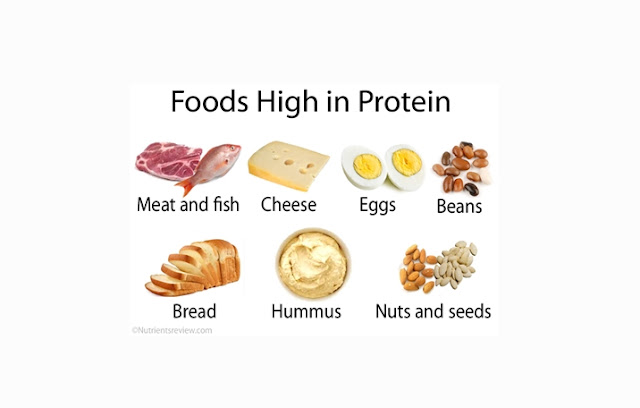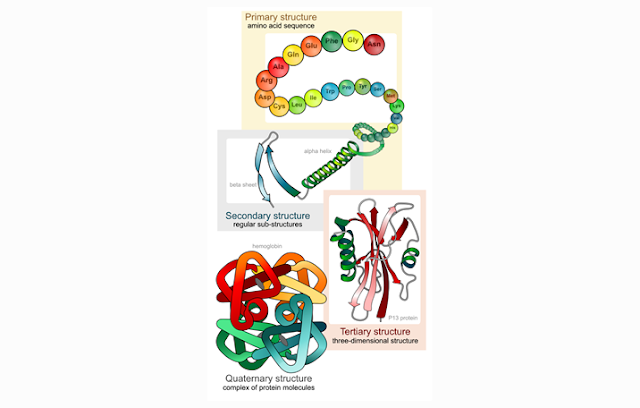A. UNDERSTANDING THE DEFINITION OF
PROTEIN
Protein is a component of organic compounds in the
form of complex macromolecules consisting of one or more polymers (chain of
atoms). The word protein comes from the Greek, the "Protos" which
means "first or foremost". This polymer composed of amino acid monomers
linked together by peptide bonds. Amino acids Atom include compounds of carbon,
hydrogen, oxygen, nitrogen and sometimes contain sulfur. Protein plays a very
important role as the structural and functional composition of living organisms
and viruses.
In biochemical terms, 20 percent of an adult's body
is protein. Protein quality is determined by the number and types of amino
acids. Proteins known as one of the giant biomolecules, can weigh 5,000 to
millions units of the molecular weight. Most proteins in the body are enzymes
or subunits of enzymes that facilitate chemical reactions in the body. Protein
can also be found as hormones, structural proteins (eg collagen), etc.
B. THE FUNCTIONS OF PROTEIN
Protein plays a very important in the human body.
Proteins has many functions, here are some of the main functions of proteins in
the body:
- As the primary source of energy after carbohydrates.
- Regulator of metabolism that occurs in the body.
- Keeping the acid-base balance and the balance of body fluids and regulating the pH of body fluids.
- Amino acids from the protein is a basic ingredient in the synthesis of hormones, antibodies, enzymes, and share another important component in the body.
- As a substance that helps the process of growth and development of organs and the human body.
- Neutralize and destroy foreign components that are harmful to the body.
- Maintenance the structure of cells, tissues and organs in the body.
C. THE STRUCTURE OF PROTEIN
As we have explained above, the protein is a polymer
composed of a chain of amino acids with a peptide bond. Each protein was
prepared based on their amino acid chain structure differences. The number and
type of amino acids in various types of protein are also varied. Protein
structures can be viewed as a hierarchy (from the smallest to the largest)
consisting of:
1. Primary
Structure of Proteins
The primary structure of proteins is a simple
structure with a sequence of linear chains of amino acids that do not form a
chain branch. The primary structure is formed by peptide bonds (amide) by
binding amino groups to the carboxyl group. This structure determines the amino
acid sequence of a polypeptide, also determines the nature and form of the
secondary structure of protein also form the tertiary.
2. Secondary
Structure of Proteins
secondary structure of protein is the structure of
the primary structure linear composition which is stabilized by hydrogen bonds.
By the force of attraction between the amino acids in the series of these
components, it will form the main structure that twisted, coiled and folded.
The results shape can be a spiral, helical, and sheets.
3. Tertiary
Structure of Proteins
The tertiary structure of proteins is a composite
structure of multiple secondary structures that would be formed as a blob.
Merger between this secondary structure can be made by hydrogen bonding, ionic
bonding, covalent bond and hydrophobic bond.
4. Quaternary
Structure of Proteins
Quaternary structure Proteins are three-dimensional
structures formed from a combination of several subunits of the protein
tertiary structure or secondary structure and primary structure. Ties that keep
the quaternary structure is non-covalent bond. These structures will form a
complex functional protein.
D. SOURCE OF PROTEIN
We get protein from foods and drink that we consume
every day. The digestive system will perform the breakdown of proteins into
amino acids that can be absorbed in the intestine. There are two types of
protein sources, namely:
- Vegetable protein, a protein source derived from plants, such as vegetables, fruits and nuts - nuts.
- Animal Protein, a protein derived from animal sources. For example, meat, eggs, milk, etc.
- The following table outlines some foods that have high protein content.
E. TYPES OF PROTEIN
1. Based on
Its compiler Components
a. Simple
Protein
Simple protein is a protein came from the result of
hydrolysis which is simply a mixture of different types of amino acids alone.
b. Complex
Proteins
Complex Proteins is a protein came from the result of
hydrolysis which has a variety of amino acids and also composed by other
components such as metals and phosphates.
c. Derivative
Proteins
Derivative Proteins is a result of hydrolysis of
partial (imperfect) native protein (base / natural protein).
2. Based On
source
a. Vegetable
protein
Vegetable protein is a protein derived from plants
such as fruits, vegetables and nuts.
b. Animal
protein
Animal protein is a protein derived from animals such
as meat, eggs and milk.
3. Based on
Their Functions
a. Complete
protein
Complete Protein is a protein that has a complete
amino acid types and quantity so that it can perform the function of growth and
can maintain the condition of a cell or tissue.
b. Less Complete Protein
Less Complete Protein is a protein with a complete
amino acid but in small amounts so it can not perform the function of growth
but still able to maintain optimal conditions of a cell or tissue.
c. Incomplete Protein
Incomplete Protein isa not perfect protein or don not
had the essential amino acids, so the function of growth and maintain optimal
conditions can not be implemented.
4. Types of
Amino Acids in Protein
a. Essential
Amino Acids
Essential amino acids are amino acids that can not be
formed by the human body. So the essential amino acids can be met from foods
derived from animals or plants.
b.
Non-Essential Amino Acids
Non-essential amino acids are amino acids that can be
formed or produced in the human body.
F. METABOLISM AND PROTEIN DIGESTION IN
THE BODY
The process of protein digestion starts since the
food enters the mouth. The food will be broken down by the process of chewing
and with the help of saliva will break down food into smaller component then push
down the food to the esophagus and into the stomach. When reached the stomach,
the chemical digestion process of food will begin. Stomach produces gastric
juice containing pepsin enzyme to digest protein. Pepsin enzyme will break down
(catabolism) proteins into simpler shapes :proteosa and peptone, both of these
groups is a short polypeptide that is still able to be absorb in the intestine.
When it goes into the small intestine, there are
pancreatic juice containing protease enzyme (protein-degrading) will parse
peptone and proteosa to be a simpler form, namely amino acids. Then in the
small intestine protein will be absorbed into the bloodstream, most proteins do
not go directly to the main blood flow, but first headed to hepatic (liver).
The liver is the main organ in the management of amino acids in the body. Once
entered into the hepar, most of the amino acids will be stored (intra-cell),
and the some of them will be circulated throughout the body by the blood. Amino
acids that stored in the liver will overhauled (anabolism) and return into
proteins form when any body part that needs it. The number of amino acids
circulating in the blood depends on the acceptance and use.





